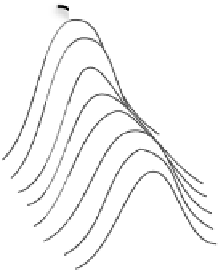Image Processing Reference
In-Depth Information
Fig. 6.5.
A model of a ridgeline on a curved surface of density values distributed
on 2D images.
The first requirement can be examined independently and point by point,
although the procedure may not always be self-evident. To test the second
requirement, we need to observe the local area of an image. From an analogy
to a 3D surface, a point may look like a ridge point if the curvature is large in
one direction and small in the direction perpendicular to it. We still need to
select experimentally or by experience some ad hoc criterion regarding how
large a curvature should be to be regarded as a ridge, because we do not have
a known standard about the value of curvatures for a ridge point.
6.4.2 Algorithm
In spite of such complexity or ambiguity in the concept of a ridge point (ridge
voxel) and a ridgeline, we will be able to derive algorithms to obtain a
ridgeline
by detecting ridge-like voxels and by following the sequence of such voxels.
We will show an example of this type of algorithm as Algorithm 6.4 below.
[Definitions used in Algorithm 6.4]
Starting condition
: Consider an arbitrary point (voxel) P of a 3D image, and
we call two voxels Q
1
and Q
2
an
adjacent voxel pair
of a voxel P, if Q
1
and Q
2
are in the 26-neighborhood of P and their locations are symmetric
with respect to P. A voxel P and its adjacent voxel pair Q
1
and Q
2
are
said to satisfy the
starting point condition
, if the following inequality holds
(Fig. 6.6).
Starting point condition
:[(
f
(P)
≥
f
(Q
1
))
∩
(
f
(P)
>f
(Q
2
))]
∪
[(
f
(
P
)
>
f
(Q
1
))
∩
(
f
(P)
≥
f
(Q
2
))], where
f
(P) means the density value of a voxel
P.
Continuity condition
: Let us represent by
k
1
,
k
2
,and
k
3
three 4D principal
curvatures at a current voxel P. Then the direction of the principal axis
corresponding to the minimum of
k
1
,
k
2
,and
k
3
is coincident to
the direc-






Search WWH ::

Custom Search